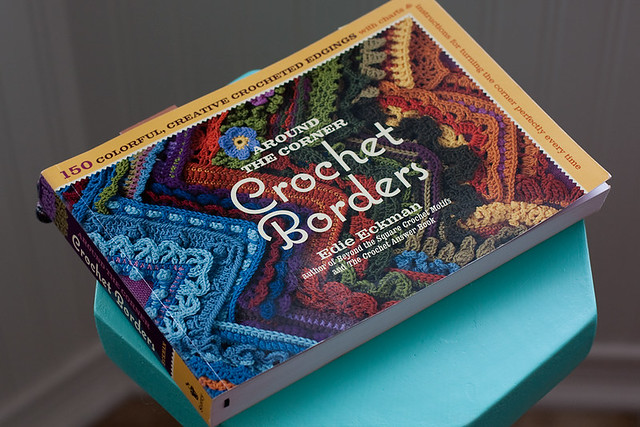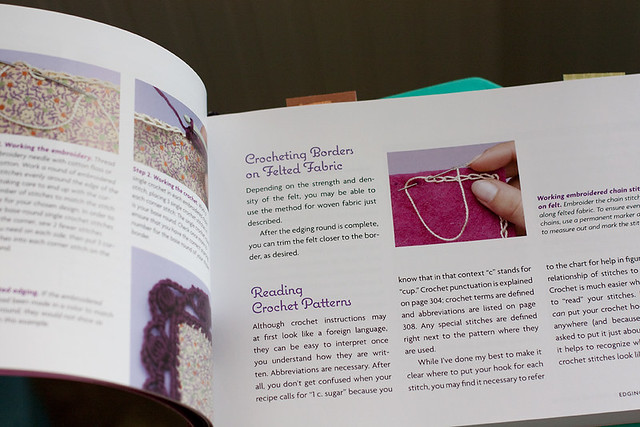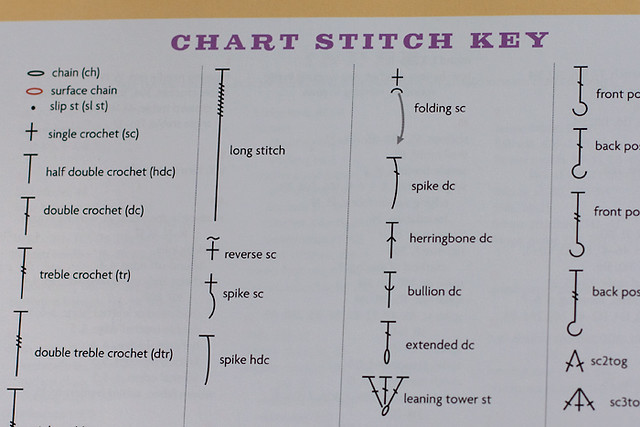Here's the second of the crochet book reviews I wrote but never published. It wasn't finished, so I've completed it, now. (In other words, the opinions expressed are quite up to date. (g))
Last time I wrote a review, it was for Edie Eckman's (first) book of crochet motifs (Beyond the Square). Today, I'm here to write a little about her book of crochet edgings-- Around the Corner Crochet Borders.

It's very similar in format to the motif book. Each border (numbered, not named) has a "symbol crochet" chart to go along with the written instructions. This is great for everyone-- people who like written patterns, people who like diagram patterns, and people who are familiar with one type of presentation but want to learn the other. The charts make most of this book accessible to any crocheter. Whether you use US or UK crochet terminology, the symbols are the same. Even if someone can't read English at all, s/he could still follow the charts. (I ♥ charts. (g))
One difference between the motif and edging books is shape and construction. Around the Corner is a paperback, non-spiral-bound book with a "landscape" (as opposed to "portrait") orientation. It's a short and wide rectangle instead of the usual taller and narrower rectangle.
As with Beyond the Square, there is an introductory section. However, in Around the Corner it seems to be expected that the reader will already know the basics of how to make crochet stitches, though all stitches are described in the glossary. (This seems a fair assumption. Few people would buy a book about crochet borders without having already acquired those basic skills.)

The introduction addresses how to work a crocheted border into knitted and crocheted fabric (including the easy horizontal edges and the trickier vertical edges-- the rough, selvage edge) and even woven or felted fabrics. (You can basically add these edgings to any fabric you want.) You'll read about how to deal with corners, how to maintain a flat edge, and how to calculate the number of stitches along an edge. There are "two new ways to join new yarn", as well as information about counting and working to corners, how to identify repeating sections of stitches, and how to end rounds (including a seamless join). Believe it or not, the list goes on. There's plenty of instruction in those first twenty-five or so pages.
On to the meat of the book!
There are 150 borders in a variety of styles and difficulties. Some are wide, some narrow. Some are dense, some lacy. A few incorporate beads or buttons. Most lie flat, but there are also ruffly edgings and some that make their own (crocheted) fringe.

Generally, each border gets two facing pages. On the left, you have the written instructions and any special stitches or notes. On the right, there is a large (not necessarily "to scale") photo of the border, a nice, clear chart, and a color key indicating which color yarn was used for the different rounds.
As in Beyond the Square, the edgings are numbered, not named. They do not seem to be organized according to difficulty, width, or other consideration.
The book closes with a section on crochet punctuation (to help you read the written patterns, if you're newer to crochet), crochet symbols (to help with reading the charts), a glossary, an index, a chart stitch key, and a page of acknowledgements.

My opinion of the strong and weak(er) points of this book are much the same as those listed in my review of Beyond the Square. (See the previous entry in this blog for that review.) Overall, my opinion of the book is quite high, and I recommend it for anyone looking for an interesting collection of crochet edging patterns.
Personally, I find a book of edgings somewhat less of a "fun to just leaf through it for all the eye-candy" type of purchase than a book of motifs, but that may not be true for everyone. The photos in this book are just as nice as in the other.
When it comes to actually using the patterns, I've probably gotten more use out of this book than Beyond the Square, so far. I've used the edgings (or variations thereof) on multiple afghans and pillows. (It's simple to add or subtract rows from many, if not all, of the patterns, depending on your needs, tastes, supply of yarn, etc.)
Though I didn't expect when I bought this book, I've found it rather useful as a stitch dictionary. When I was working on a sampler afghan, some of my squares came out too small. I believe I used this book as inspiration for some of my additional rows. Just look through the book until you find something that appeals to you, then use that pattern to add on another few rows to the square. You need to know how many stitches the square currently has, then the book's charts make it clear whether your counts will come out right or not-- in which case you can adjust or fudge it. The fact that you have a pattern for turning the corner makes it ideal for this use!
I know I used this book as a stitch dictionary when I was working on the random strips/stripes in my Citric Acid Retroghan. When I was lacking in ideas for what to do next, a quick flip through its pages would provide something I wouldn't have thought of on my own. Take the patterns a row or two (or more) at a time, juggle them according to your personal style, and you'll have a truly one-of-a-kind "random stripes" afghan.
Around the Corner Crochet Borders has turned out to be a useful resource to have in my little library of craft books-- one I wouldn't care to do without.
- - - - - - -
Last time I wrote a review, it was for Edie Eckman's (first) book of crochet motifs (Beyond the Square). Today, I'm here to write a little about her book of crochet edgings-- Around the Corner Crochet Borders.

It's very similar in format to the motif book. Each border (numbered, not named) has a "symbol crochet" chart to go along with the written instructions. This is great for everyone-- people who like written patterns, people who like diagram patterns, and people who are familiar with one type of presentation but want to learn the other. The charts make most of this book accessible to any crocheter. Whether you use US or UK crochet terminology, the symbols are the same. Even if someone can't read English at all, s/he could still follow the charts. (I ♥ charts. (g))
One difference between the motif and edging books is shape and construction. Around the Corner is a paperback, non-spiral-bound book with a "landscape" (as opposed to "portrait") orientation. It's a short and wide rectangle instead of the usual taller and narrower rectangle.
As with Beyond the Square, there is an introductory section. However, in Around the Corner it seems to be expected that the reader will already know the basics of how to make crochet stitches, though all stitches are described in the glossary. (This seems a fair assumption. Few people would buy a book about crochet borders without having already acquired those basic skills.)

The introduction addresses how to work a crocheted border into knitted and crocheted fabric (including the easy horizontal edges and the trickier vertical edges-- the rough, selvage edge) and even woven or felted fabrics. (You can basically add these edgings to any fabric you want.) You'll read about how to deal with corners, how to maintain a flat edge, and how to calculate the number of stitches along an edge. There are "two new ways to join new yarn", as well as information about counting and working to corners, how to identify repeating sections of stitches, and how to end rounds (including a seamless join). Believe it or not, the list goes on. There's plenty of instruction in those first twenty-five or so pages.
On to the meat of the book!
There are 150 borders in a variety of styles and difficulties. Some are wide, some narrow. Some are dense, some lacy. A few incorporate beads or buttons. Most lie flat, but there are also ruffly edgings and some that make their own (crocheted) fringe.

Generally, each border gets two facing pages. On the left, you have the written instructions and any special stitches or notes. On the right, there is a large (not necessarily "to scale") photo of the border, a nice, clear chart, and a color key indicating which color yarn was used for the different rounds.
As in Beyond the Square, the edgings are numbered, not named. They do not seem to be organized according to difficulty, width, or other consideration.
The book closes with a section on crochet punctuation (to help you read the written patterns, if you're newer to crochet), crochet symbols (to help with reading the charts), a glossary, an index, a chart stitch key, and a page of acknowledgements.

- - - - - - -
My opinion of the strong and weak(er) points of this book are much the same as those listed in my review of Beyond the Square. (See the previous entry in this blog for that review.) Overall, my opinion of the book is quite high, and I recommend it for anyone looking for an interesting collection of crochet edging patterns.
Personally, I find a book of edgings somewhat less of a "fun to just leaf through it for all the eye-candy" type of purchase than a book of motifs, but that may not be true for everyone. The photos in this book are just as nice as in the other.
When it comes to actually using the patterns, I've probably gotten more use out of this book than Beyond the Square, so far. I've used the edgings (or variations thereof) on multiple afghans and pillows. (It's simple to add or subtract rows from many, if not all, of the patterns, depending on your needs, tastes, supply of yarn, etc.)
Though I didn't expect when I bought this book, I've found it rather useful as a stitch dictionary. When I was working on a sampler afghan, some of my squares came out too small. I believe I used this book as inspiration for some of my additional rows. Just look through the book until you find something that appeals to you, then use that pattern to add on another few rows to the square. You need to know how many stitches the square currently has, then the book's charts make it clear whether your counts will come out right or not-- in which case you can adjust or fudge it. The fact that you have a pattern for turning the corner makes it ideal for this use!
I know I used this book as a stitch dictionary when I was working on the random strips/stripes in my Citric Acid Retroghan. When I was lacking in ideas for what to do next, a quick flip through its pages would provide something I wouldn't have thought of on my own. Take the patterns a row or two (or more) at a time, juggle them according to your personal style, and you'll have a truly one-of-a-kind "random stripes" afghan.
Around the Corner Crochet Borders has turned out to be a useful resource to have in my little library of craft books-- one I wouldn't care to do without.
